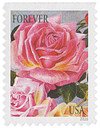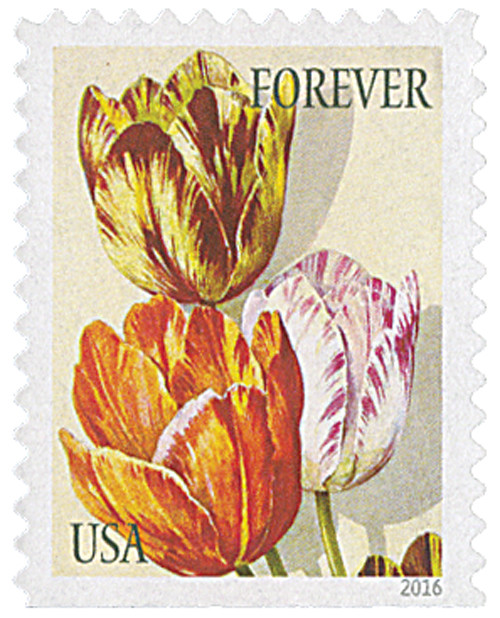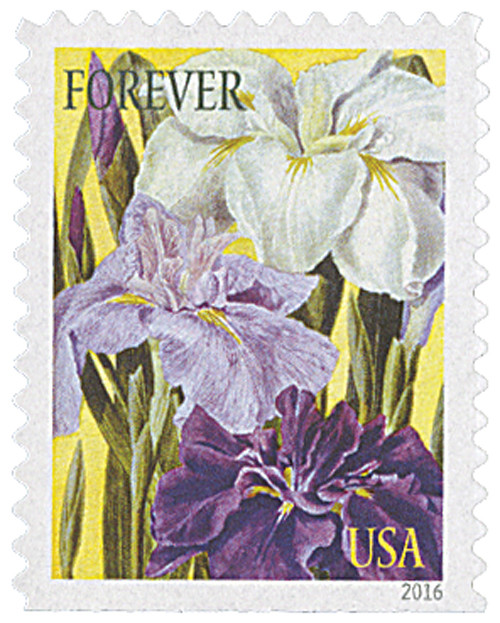
# 5047 - 2016 First-Class Forever Stamp - Botanical Art: Roses
US #5047
2016 Roses – Botanical Art
- Celebrates botanical artwork in American nursery catalogs printed between 1891 and 1912
Stamp Category: Definitive
Set: Botanical Art
Value: 49¢ First Class Mail Rate (Forever)
First Day of Issue: January 29, 2016
First Day City: Atlanta, Georgia
Quantity Issued: 60,000,000
Printed by: Ashton Potter
Printing Method: Offset
Format: Booklets of 10 OR Double-sided booklets of 20
Tagging: Nonphosphored type III, block tag applied
Why the stamp was issued: To continue the tradition of printing floral-themed US stamps.
About the stamp design: Pictures roses from an American nursery catalog printed between 1891 and 1912. The catalog was from The New York Botanical Garden’s Nursery and Seed Catalog Collection.
First Day City: The First Day of Issue Ceremony was held at the American Philatelic Society’s AmeriStamp/Southeastern Stamp Expo. at the Hilton Atlanta in Atlanta, Georgia.
About the Botanical Art set: 10 stamps all picturing different artwork from a 100+ year old American nursery catalog. Species pictured include: corn lilies, tulips, dahlias, stocks, roses, Japanese irises, petunias, and jonquils.
History the stamp represents: For a gardener, one highlight of the winter can be the arrival of seed catalogs. As the snow flies, dreams turn to ideas and plans for springtime gardening. But seeds are only one of four major ways to being a plant, and all methods offer a gardener plenty to enjoy year round.
Seeds are tiny embryos, wrapped in a seed coat, that usually store food to nourish the new plant until it can produce its own. Usually sown – scattered or lightly covered with soil – seeds may be annual, biennial, or perennial.
Bulbs can be thought of as containers that hold what will become the mature plant structure. They are always perennial and also store food for the plant as it goes through a dormant period. Two types of bulbs exist – one with a papery covering and another without.
Root cuttings are easy to do and a great source of free plants. The secrets to successful cuttings are to pick a healthy plant that is well hydrated, use a clean knife to take the cutting, and plant it in a soilless medium until the roots form.
Grafting involves inserting a 3-4 inch shoot (new growth) into a sturdy plant of a different variety and binding them tightly. In time, a shoot will form. Grafting is done to create hybrid roses, and can yield exciting results.
US #5047
2016 Roses – Botanical Art
- Celebrates botanical artwork in American nursery catalogs printed between 1891 and 1912
Stamp Category: Definitive
Set: Botanical Art
Value: 49¢ First Class Mail Rate (Forever)
First Day of Issue: January 29, 2016
First Day City: Atlanta, Georgia
Quantity Issued: 60,000,000
Printed by: Ashton Potter
Printing Method: Offset
Format: Booklets of 10 OR Double-sided booklets of 20
Tagging: Nonphosphored type III, block tag applied
Why the stamp was issued: To continue the tradition of printing floral-themed US stamps.
About the stamp design: Pictures roses from an American nursery catalog printed between 1891 and 1912. The catalog was from The New York Botanical Garden’s Nursery and Seed Catalog Collection.
First Day City: The First Day of Issue Ceremony was held at the American Philatelic Society’s AmeriStamp/Southeastern Stamp Expo. at the Hilton Atlanta in Atlanta, Georgia.
About the Botanical Art set: 10 stamps all picturing different artwork from a 100+ year old American nursery catalog. Species pictured include: corn lilies, tulips, dahlias, stocks, roses, Japanese irises, petunias, and jonquils.
History the stamp represents: For a gardener, one highlight of the winter can be the arrival of seed catalogs. As the snow flies, dreams turn to ideas and plans for springtime gardening. But seeds are only one of four major ways to being a plant, and all methods offer a gardener plenty to enjoy year round.
Seeds are tiny embryos, wrapped in a seed coat, that usually store food to nourish the new plant until it can produce its own. Usually sown – scattered or lightly covered with soil – seeds may be annual, biennial, or perennial.
Bulbs can be thought of as containers that hold what will become the mature plant structure. They are always perennial and also store food for the plant as it goes through a dormant period. Two types of bulbs exist – one with a papery covering and another without.
Root cuttings are easy to do and a great source of free plants. The secrets to successful cuttings are to pick a healthy plant that is well hydrated, use a clean knife to take the cutting, and plant it in a soilless medium until the roots form.
Grafting involves inserting a 3-4 inch shoot (new growth) into a sturdy plant of a different variety and binding them tightly. In time, a shoot will form. Grafting is done to create hybrid roses, and can yield exciting results.














